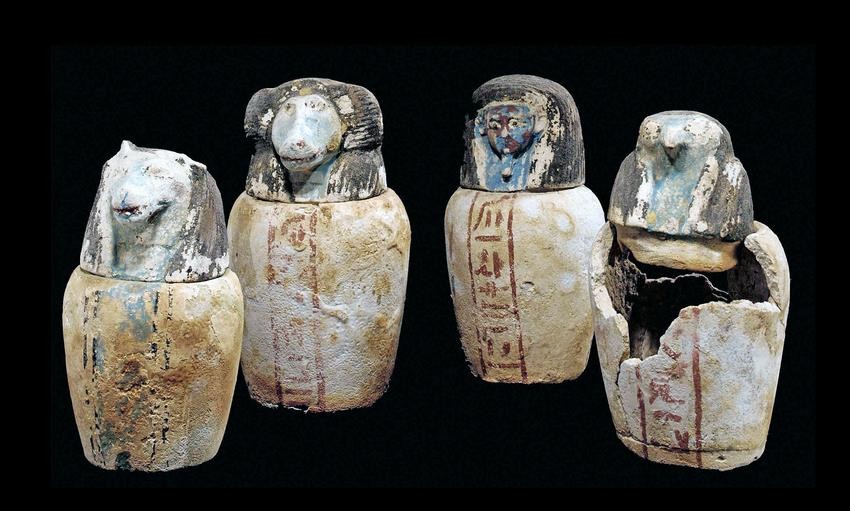Rare Set Egyptian 26th Dynasty Canopic Jars - Art Loss
Ancient Egypt, Late Dynastic Period, 26th Dynasty, ca. 664 to 525 BCE. A rare complete set of white and blue glazed faience canopic jars. Each is figural with its lid in the form of a head. Each represents one of the four Sons of Horus: Duamutef (jackal form), Imsety (human form), Hapi (baboon form), and Qebehsenuef (hawk form). Horus's sons were the ones charged with protecting the internal organs, as they had originally been charged with protecting the body of Osiris. All together here, they have a pleasing symmetry, with similar mummiform bodies and only their headdresses distinguishably different. Each is painted with blue faience pigment on the face and wears a heavy black wig; the bodies, in contrast, are largely creamy white, with a thin, vertical stripe of painted hieroglyphs in a narrow border down from the front of each face to the base of the jar. This strip states the name of each. Size of tallest: 8" H (20.3 cm)
Canopic jars are some of the most iconic artifacts from Egypt, made to hold the viscera removed during the mummification process. This tradition lasted for an incredibly long time - the first evidence for a canopic chest containing organs comes from the Fourth Dynasty (ca. 2600 BCE) and they were used into the late 1st millennium BCE. Today, the remains placed in these jars are yielding interesting scientific results, as archaeologists look at ancient bacteria found inside the ancient viscera. Finding all four preserved together as they are here is remarkable!
This piece is accompanied by an Art Loss Certificate.
Provenance: private New York, USA collection; ex-private Swiss collection, acquired in 1992
All items legal to buy/sell under U.S. Statute covering cultural patrimony Code 2600, CHAPTER 14, and are guaranteed to be as described or your money back.
A Certificate of Authenticity will accompany all winning bids.
We ship worldwide to most countries and handle all shipping in-house for your convenience.
#152807 Dimensions: Condition Report: All four heads are in nice condition aside from a loss to one ear on Duamutef. The body of Qebehsenuef is repaired from eight or nine pieces and has some losses as shown. Hapi is also repaired from several pieces and has some small losses around the rim. Imsety is repaired at the back of the body. Duamutef has a small area of repair along the neck and small losses around that area. All have some small losses to peripheries and wear commensurate with age. Great deposits on surface and well-preserved pigment on all as shown.
View it on
Estimate
Time, Location
Auction House
Ancient Egypt, Late Dynastic Period, 26th Dynasty, ca. 664 to 525 BCE. A rare complete set of white and blue glazed faience canopic jars. Each is figural with its lid in the form of a head. Each represents one of the four Sons of Horus: Duamutef (jackal form), Imsety (human form), Hapi (baboon form), and Qebehsenuef (hawk form). Horus's sons were the ones charged with protecting the internal organs, as they had originally been charged with protecting the body of Osiris. All together here, they have a pleasing symmetry, with similar mummiform bodies and only their headdresses distinguishably different. Each is painted with blue faience pigment on the face and wears a heavy black wig; the bodies, in contrast, are largely creamy white, with a thin, vertical stripe of painted hieroglyphs in a narrow border down from the front of each face to the base of the jar. This strip states the name of each. Size of tallest: 8" H (20.3 cm)
Canopic jars are some of the most iconic artifacts from Egypt, made to hold the viscera removed during the mummification process. This tradition lasted for an incredibly long time - the first evidence for a canopic chest containing organs comes from the Fourth Dynasty (ca. 2600 BCE) and they were used into the late 1st millennium BCE. Today, the remains placed in these jars are yielding interesting scientific results, as archaeologists look at ancient bacteria found inside the ancient viscera. Finding all four preserved together as they are here is remarkable!
This piece is accompanied by an Art Loss Certificate.
Provenance: private New York, USA collection; ex-private Swiss collection, acquired in 1992
All items legal to buy/sell under U.S. Statute covering cultural patrimony Code 2600, CHAPTER 14, and are guaranteed to be as described or your money back.
A Certificate of Authenticity will accompany all winning bids.
We ship worldwide to most countries and handle all shipping in-house for your convenience.
#152807 Dimensions: Condition Report: All four heads are in nice condition aside from a loss to one ear on Duamutef. The body of Qebehsenuef is repaired from eight or nine pieces and has some losses as shown. Hapi is also repaired from several pieces and has some small losses around the rim. Imsety is repaired at the back of the body. Duamutef has a small area of repair along the neck and small losses around that area. All have some small losses to peripheries and wear commensurate with age. Great deposits on surface and well-preserved pigment on all as shown.



